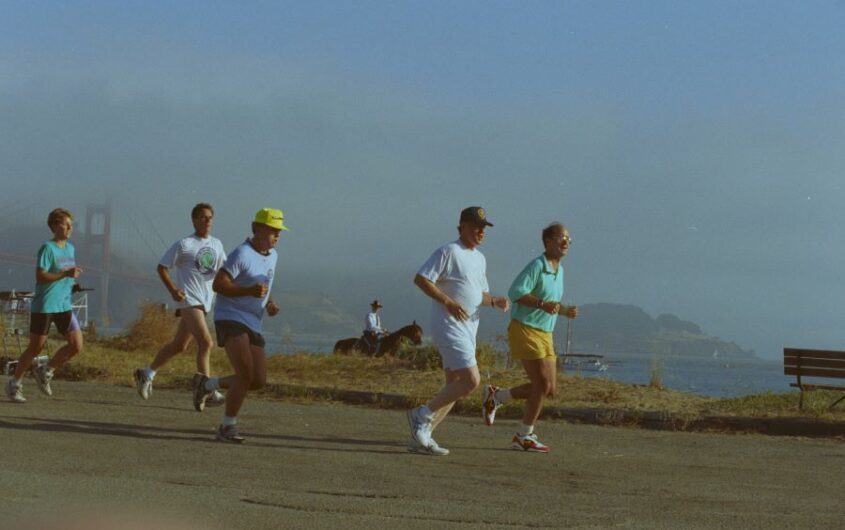
Courtesy, William J. Clinton Presidential Library
The Secret of Strobe Talbott’s and Bill Clinton’s Friendship

Stephan Kieninger
Historian
Stephan Kieninger holds a PhD in Modern History from Mannheim University and had previously been a Wilson Fellow at the Woodrow Wilson Center, a postdoc at Johns Hopkins SAIS, a fellow at the Berlin Center for Cold War Studies, and a Senior Researcher at the Federal German Archives.
He is the author of three books on U.S. foreign policy and European security in the Cold War and after: Securing Peace in Europe. Strobe Talbott, NATO, and Russia after the Cold War (Columbia University Press, 2025), The Diplomacy of Detente. Cooperative Security Policies from Helmut Schmidt to George Shultz (Routledge, 2018), Dynamic Détente: The United States and Europe, 1964–1975 (Rowman & Littlefield, 2016), and has received fellowships from the German Historical Institute, the Hoover Institution, and the German Academic Exchange Service.
New Insight from Strobe Talbott’s Diaries
Senior staff turnovers within the White House or the executive branch are not uncommon. There are many reasons, including firing, exhaustion, overwork, political loyalty, and the arrival of new talent. In contrast, during the 1990s, Strobe Talbott was at President Bill Clinton’s side essentially through all of his eight years in office and remained a source of discreet advice to the president, first as Russia adviser and then for seven years as Deputy Secretary of State. Their relationship was grounded in a decades-old intellectual partnership and friendship. How did the trust between Clinton and Talbott affect the advice and policies that resulted?
Both saw their friendship as an ongoing conversation about the world and international affairs, which started during their time as Rhodes Scholars and housemates at Oxford almost fifty years ago. In September 1968, they first met in Philadelphia, taking a bus to New York City and traversing to the United Kingdom aboard the SS United States. It turned out that both had a common interest in Russia and its history. “My first conversation of any substance with him was during the ocean crossing,” Talbott recalled, “and the subject was the Soviet Union, the giant, alien, antagonistic country that had preoccupied U.S. foreign policy all our lives.”[1]
The bond between Clinton and Talbott grew closer in Oxford when Talbott edited and translated Nikita Khruschev’s memoirs and took Clinton into his confidence. In his memoirs, Talbott recalled that Clinton “savored being in on a secret project. He was a night owl, while I was a morning person. But during that spring, he adjusted his schedule to mine, often getting up early to fry eggs for breakfast. I’d take a break from my work and sit with him in the kitchen, regaling him with tales of Kremlin skull-duggery that I’d gleaned from the thick stack of transcripts strewn around my room.”[2] Their friendship has always been based on intellectual curiosity and a joint interest in Russian history. Talbott visited the Soviet Union in 1968. Clinton followed suit in 1970.[3] These shared experiences created a platform for dialogue.
Moreover, both constantly discussed foreign policy, borrowed books from each other, and maintained this pattern during Clinton’s presidency. Clinton appreciated that Talbott always said things as he saw them—he was straightforward and unvarnished in his communication with the president. Clinton could pick Talbott’s brain on every foreign policy issue. He could rely on Talbott’s judgment and benefited from his independent counsel.
Talbott’s friendship with Clinton was helpful in day-to-day government business. Everyone knew Talbott had the president’s trust. Talbott never bragged about their friendship. He never called the president by his first name in the presence of others. In his memoranda and letters to Clinton, he usually called him “Chief.” Regarding his status in the circle of Clinton’s advisers, Talbott said that he was “by no means the only person in his circle who’s known him a long time. I do not have any sense of having a unique position or even a primary position.”[4]
Still, Clinton relied on Talbott’s creativity and capacity to think out of the box. In 1993, Clinton and Talbott did not follow the conventional wisdom to be cautious toward Russia’s fledgling reform project. Talbott’s advice for Clinton was to think big, strike an alliance with Russian reformers, and foster the country’s integration into the family of democratic nations. Moreover, both were determined to include Ukraine and Russia’s other neighbors in the post-Cold War security architecture. In January 1993, Talbott noted in his diaries that Clinton wanted “a policy that takes account of all the former republics, that deals holistically or gestalt-like with Russia in its relations with the other republics; feels that policy till now has tended to treat Russia a vacuum, or to pit the issue of the other republics (especially Balts and Ukraine) against the issue of Russia; goal: a true commonwealth; peace and cooperation between Russia and the new abroad.”
Clinton and Talbott did not follow the conventional wisdom to be cautious toward Russia’s fledgling reform project. Talbott’s advice for Clinton was to think big.
Despite his Ivy League polish and his ambition, Talbott was not in government for careerist reasons. He did not seek the limelight and often stayed in the background. He already had a magnificent career in journalism and had written five books on U.S.-Soviet relations during his twenty-two-year tenure at Time Magazine. He had been one of the country’s leading Sovietologists. “I’m not trying to do a good job in order to get a better job afterward,” Talbott wrote in a diary entry in March 1993. “I’m in it to do a good job, period—or at least to get credit for trying.” Concerning his career plans, Talbott did not rule out the possibility of returning to Time after a few years in government. “If I stay two years, three years, four years—I can leave with my head held high; and if I’ve done respectably,” he thought. “I’ll be perfectly hirable for something next—including going back to Time and Time Inc., if there’s anything there worth going back to.”
Sometimes, Clinton sought Talbott’s advice on issues beyond his portfolio. On April 25, 1993, for instance, Clinton called Talbott to get his take on the war in Bosnia, a key foreign policy issue that was not part of Talbott’s area of responsibility at the time. Talbott did not endorse the ideas that the Clinton administration proposed, namely, to lift the arms embargo to establish “military parity” between the conflict parties. Talbott thought, “it’s like squeezing the balloon—if you intensify the civil war in Bosnia, you provoke the Serbs to intensify their activity against Kosovo and Macedonia, which is where the whole thing has the worst danger of going regional/international.”
Instead, Talbott told Clinton about the need for a more muscular approach and NATO’s leadership to project peace in the Balkans. In April 1993, Talbott’s thinking foreshadowed much of the action that NATO took to end the war in 1995. Yet, it differed significantly from the counsel the president got from leadership personnel at the White House and the Pentagon working full time on Bosnia and former Yugoslavia. While on the phone with Clinton, Talbott argued that “we’ve got to take out the Serbian military; that means mostly airstrikes, but against air bases, etc., in Serbia as well as against artillery installations in Bosnia. It also means leading an international force afterward to keep everyone from everyone else’s throats afterward.”
In addition to his expertise, Talbott’s success at the State Department resulted from his ability to work with Clinton’s Secretaries of State Warren Christopher and Madeleine Albright. After a call from the president, Talbott always informed Albright and Christopher. Moreover, he used memoranda, notes, and letters to engage Christopher, who was cautious and almost shy in personal meetings. After he was appointed Deputy Secretary, Talbott started to send Christopher notes for the secretary’s eyes only to facilitate new initiatives. Christopher appreciated the memos and usually returned them with plenty of annotations and comments. Talbott would rework it, incorporate Christopher’s thoughts, and then share it with the key people in the State Department’s leadership before it was put into the bureaucratic process. This way of working was a win-win: Christopher could exercise leadership quietly, and Talbott had the opportunity to inject his ideas into the policymaking process from the start.[5]
Spatial separation was perhaps another recipe for the longevity of Clinton’s and Talbott’s friendship. Clinton never asked Talbott to work at the White House. From Clinton’s vantage point, Talbott was more valuable at the State Department and would have even remained valuable if he had left government. In November 1996, Talbott was not certain if he would stay on. At the time, Secretary of Labor Robert Reich, another former Rhodes Scholar, confided to Talbott that “someone very close to POTUS had just told him earlier in the day, ‘if you leave the gov’t, your I.Q. in the president’s estimation will go up 10 points.’ In other words, POTUS’ desire to have your advice is inversely proportional to proximity.” Clinton and Talbott did not see each other every day. They had daily telephone conversations, but their meetings and interactions always had a specific purpose, were solution-oriented, and did not just reflect lengthy bureaucratic routines that Clinton did not appreciate.
Another factor was Clinton’s and Talbott’s ability to learn from mistakes, such as from the poor preparations and misunderstandings in the context of Clinton’s unproductive meeting with Russian President Boris Yeltsin in December 1994 in Budapest, when the latter criticized Clinton in public over NATO enlargement. Talbott was the key advocate of the meeting but could not participate due to his assignments to deal with the aftermath of the Haiti crisis in 1994. After the confrontation between Clinton and Yeltsin, Talbott reasserted his stewardship of the U.S.-Russia relationship. He would never miss a Clinton-Yeltsin summit again. In May 1995, for instance, Clinton emphasized that he wanted Talbott at his side during his forthcoming visit to Moscow. “I’m devoting 110% of my time to making the meeting a success,” Talbott said. “And if I fuck up and it’s a bad meeting, you can leave me there, but I’ll try to get you there and back without being sorry.” Indeed, Talbott helped Clinton to bring the relationship with Russia back on track. He provided the kind of practical advice that Bill Clinton sought to keep Russian President Yeltsin engaged.
Talbott’s memoir The Russia Hand symbolizes his friendship with Clinton. When the book was published in 2002, commentators were surprised to find that President Clinton was the Russia hand and the main character in the book. Talbott did not write it to aggrandize his own achievements. Instead, the book emphasizes Clinton’s key contributions as a formidable hands-on negotiator and diplomat-in-chief. In September 2000, Talbott began to contemplate writing the book. He told Clinton about his plans and the book’s storyline, laying out his ideas in a phone conversation on September 28, 2000. “I tell him about my plan to write a book about him and Yeltsin,” Talbott noted. “I recall how he’d once said that he trusted me not to write a memoir that made him look like an asshole and how I didn’t take that as forbidding me from writing any memoir at all. He laughed and said, ‘You got it!’ and it sounded like a good book. I told him more than that, we had a good story to tell, and how I wanted to tell it. ‘Go for it,’ he said,” Talbott recorded in his diary. It was helpful that Clinton and Talbott had a similar sense of humor.
This essay adapts passages from Stephan Kieninger’s upcoming book Securing Peace in Europe: Strobe Talbott, NATO, and Russia after the Cold War. It will be published by Columbia University Press and can be pre-ordered here.
[1] Strobe Talbott, The Russia Hand: A Memoir of Presidential Diplomacy (New York: Random House, 2002), 11.
[2] Talbott, Russia Hand, 14.
[3] Bill Clinton, My Life (New York: Alfred A. Knopf, 2004), 167–70.
[4] Cathy Horyn, “Strobe Talbott’s Fifth Estate,” Washington Post, July 14, 1994.
[5] See Stephan Kieninger, Securing Peace in Europe. Strobe Talbott, NATO, and Russia after the Cold War (New York: Columbia University Press, 2025): https://cup.columbia.edu/book/securing-peace-in-europe/9780231217712/.








